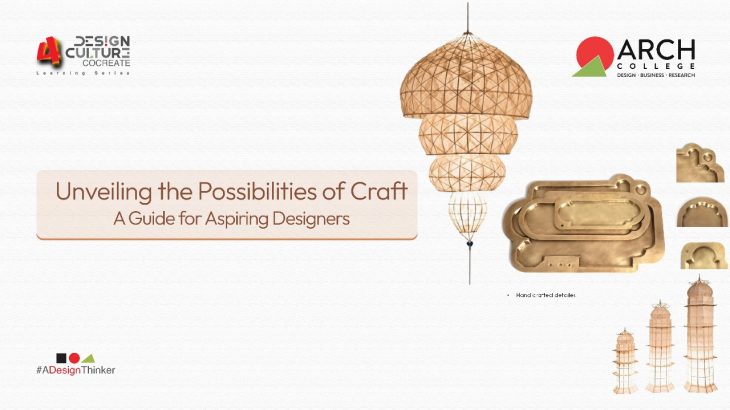“Art is the most beautiful of crafts. Craft is the most beautiful of arts.” — Frank Lloyd Wright
What makes every craft special is its bespoke nature—no two pieces are exactly alike! Each crafted piece tells a story, reflecting the maker’s vision and the cultural traditions from which it originates. Crafts are not merely products; they are expressions of artistry and culture, preserving age-old techniques and imbuing everyday objects with history and meaning.
Craft and design have always been closely connected, with craft often laying the groundwork for design to shine. As design students, you know the importance of paying attention to detail, choosing the right materials, and the satisfaction of creating something with your own hands. But in our fast-paced, tech-driven world, you might wonder: Can craft keep up with the demands of mass production? Can the personal touch of craftsmanship blend with large-scale manufacturing and commercial success?
The managing director of Anantaya, Ms. Geetanjali Kasliwal, addressed these questions during her session as part of the Design Culture Co-Create Learning Series, offering valuable insights on how craft and design can intersect and thrive in a modern, mass-production environment. Here’s how you can leverage the exciting potential of craft to shape your design journey and make a difference:
Luxury Beyond the Price Tag
In the global market, there is a growing appreciation for the authenticity and quality that craft offers. Consumers are increasingly seeking handcrafted items that stand out from mass-produced goods. The value of craft is not always reflected in its price tag but in the experience and personal connection it fosters. The process of creating or acquiring a handcrafted item often involves a journey of discovery and appreciation.
Luxury in craft is embodied by the rarity and uniqueness of each piece. Craftsmanship stands out because of its inherent scarcity; each handcrafted item is a rare, personalized creation that offers a level of quality and individuality not found in mass-produced goods. Ms. Geetanjali Kasliwal said it perfectly: “Just as a special meal or a relaxing weekend is a cherished and luxurious experience because of its context and rarity, handcrafted items are considered luxurious because they offer something unique and extraordinary in a world of uniformity.”

Bridging History and the Future
Crafts are a profound link to our history and traditions, offering a tangible connection to the past through techniques and materials. Each handcrafted item carries the essence of cultural heritage and historical narratives, reflecting the values and artistry of bygone eras. As designers, it is our responsibility to bridge this rich past with contemporary aesthetics, creating timeless designs that honor and represent our cultural heritage.

Ms. Geetanjali Kasliwal showcased Anantaya’s Imaarat trays as a prime example of how traditional inspiration can be transformed into versatile, contemporary designs. The name “Imaarat,” meaning ‘building,’ reflects the trays’ design inspiration drawn from the abstracted floor plans of Rajasthani palaces. These trays, beautifully crafted from hand-beaten brass sheets, are functional and serve as artistic statements.
The Green Side of Crafts
Crafts are inherently sustainable due to their reliance on natural materials and practices that prioritize environmental responsibility. The craft tradition often embraces upcycling, reuse, and recycling, transforming discarded or surplus materials into valuable new creations.

This approach reduces waste and minimizes the need for new resources. By focusing on these sustainable practices, crafts contribute to a more eco-friendly and circular economy, aligning with modern values of environmental stewardship and resource conservation.
Ms. Geetanjali Kasliwal provided an example of a palm collection crafted by Rajasthan artisans. This collection includes furniture, bags, and various other crafts, all made from palm leaves.
Revival of Traditional Techniques
Adapting design approaches is crucial for maintaining the relevance and vitality of craftsmanship. It involves embracing change, finding innovative solutions, and continuously integrating new ideas while honoring traditional practices. This adaptability not only helps in overcoming obstacles but also drives forward creative and impactful design solutions.

The speaker illustrated this with the story of a community known for crafting bird cages, who faced challenges when their traditional practice was banned. In response, the artisans transitioned by applying their skills to furniture design, drawing inspiration from the intricate patterns of their birdcages. This shift allowed them to continue showcasing their craftsmanship and demonstrated how adapting design methods can help artisans overcome obstacles and innovate within new contexts.
From Small Scale to Grand Designs
Crafts are often associated with smaller, intricate items, but they can be scaled up to accommodate larger spaces and sizes. The beauty of craftsmanship lies in its adaptability; traditional techniques can create substantial, impressive pieces that serve larger functions. Additionally, crafts can expand beyond regional boundaries, making a significant impact in the worldwide market.

The large statues of hand mudras installed at New Delhi Airport showcase the grandeur and adaptability of craft in public art. Ms. Geetanjali pointed to various space-designing projects by Anantaya in Dubai and Washington, where crafts have been integrated into large-scale architectural and interior design elements.
In Summary
At ARCH, we organize learning sessions with industry experts covering various design aspects. These sessions provide students with firsthand insights into practical and innovative approaches. By engaging with professionals like Ms. Geetanjali Kasliwal, students learn how to apply concepts in real-world scenarios, such as scaling crafts for larger spaces and international markets. These organized sessions enrich their education, offering inspiration and equipping them with valuable skills and perspectives for their future design careers.
To explore more creative topics and sessions, be sure to read our blogs on the Learning Series. They offer a wealth of information and insights from various experts, providing a deeper understanding of different design aspects and approaches.
